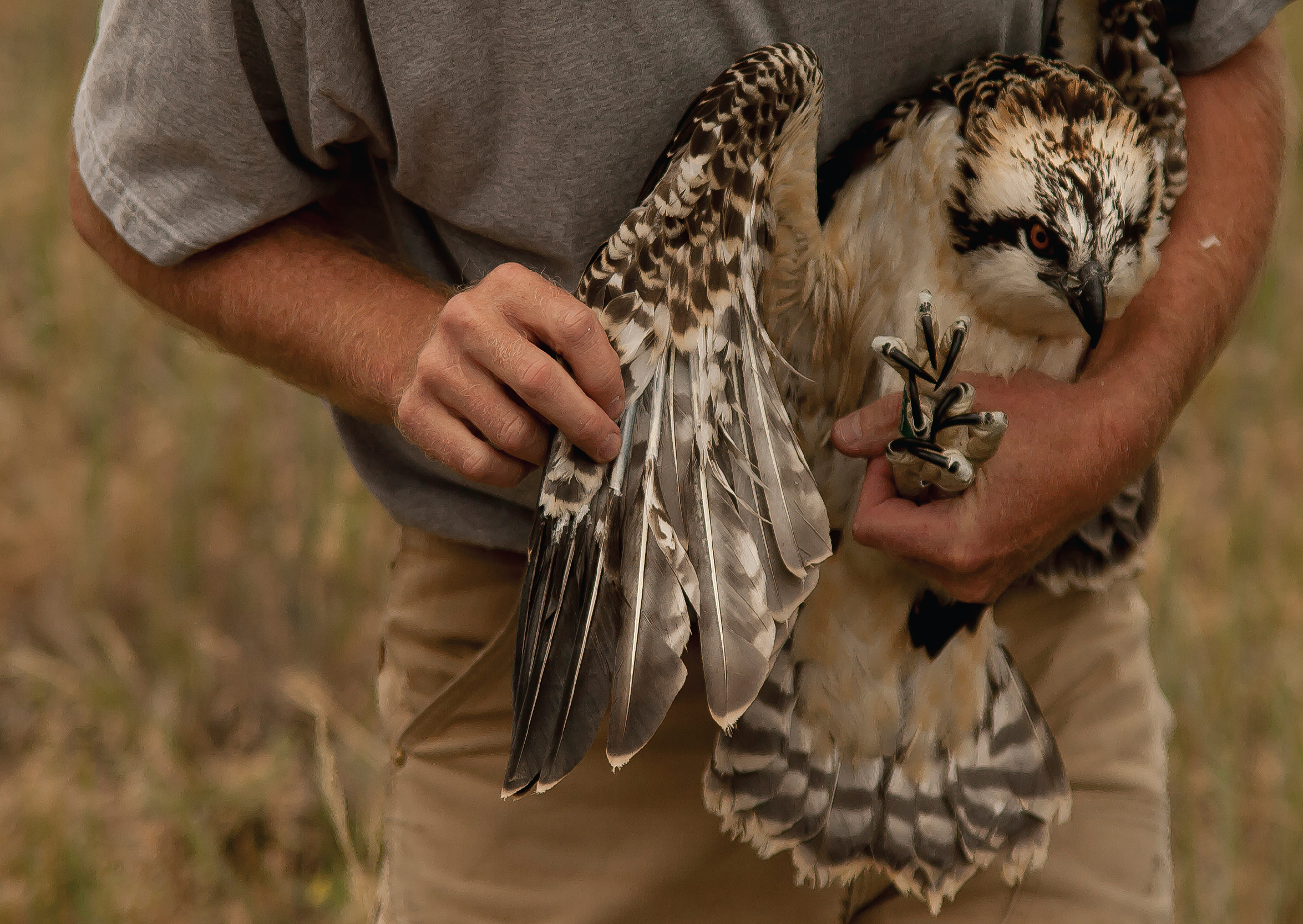
16 Oct The Osprey Project: With the use of volunteer nest monitors, Marco Restani helps osprey populations soar
IN A ROOM ON THE LOWER LEVEL OF THE Livingston-Park County Library in Montana, a group of more than 15 people listen to Marco Restani talk about ospreys. He starts by discussing how, after World War II and up through the early 1970s, osprey populations in the U.S. plummeted because of the use of the pesticide DDT. As it did to bald eagles, peregrine falcons, and other bird species, DDT, used primarily in agriculture, weakened osprey eggshells. Easily crushed, the embryos were more likely to die. In 1972, the Environmental Protection Agency (EPA) was created, and DDT was banned in the U.S. Since then, osprey numbers have been increasing.
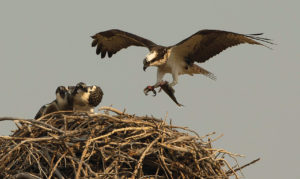
Ospreys primarily feed their chicks fish until they are ready to fledge.
Each of the volunteers listening to Restani’s talk is set to adopt one or more osprey nests in the coming spring. Their main duty is to visit their designated nest for 30 minutes every week or two until the birds fly south for the winter. Nest monitors record dates and data, including the ospreys’ first arrival at the nest, and notes on nest building, copulation, incubation, brooding, fledgling, and other behaviors. “It’s a citizen science project,” Restani says. “The volunteers learn about science, and they are becoming scientifically literate. They learn about the benefits of science and conservation.”
The potential volunteers at the library are part of a group of 40 people who offer up their time and mileage to make a research project of this magnitude — including the monitoring of more than 80 nests along the Yellowstone River from Gardiner to Miles City — possible.
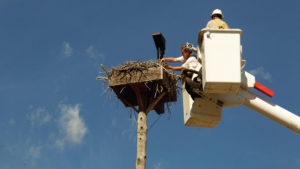
Marco Restani works with a number of utility operators to monitor osprey nests along the Yellowstone River.
Though they live on every continent except Antarctica, ospreys are one of Montana’s most recognizable and iconic raptors. John James Audubon wrote of ospreys, “The habits of this famed bird differ so materially from those of almost all others of its genus, that an accurate description of them cannot fail to be highly interesting to the student of nature.”
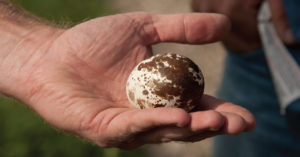
Osprey eggs are about the same size as that of a large hen.
Since they depend on fish in healthy rivers, ponds, and oceans to survive, ospreys are good indicators of environmental quality. If they are thriving, it’s likely the water they fish from is healthy. Restani is a self proclaimed “raptor guy” and focuses his studies on the ospreys’ natal dispersal (where they go when they leave the nest) and long distance movements, but he couldn’t do that without the help of volunteer nest monitors, power companies, private landowners, and others who connect the birds across the landscape and with each other.
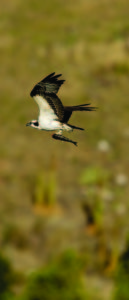
The Osprey Project seeks to better understand osprey ecology to inform management decisions by monitoring more than 80 nests along the Yellowstone River corridor.
The Yellowstone Valley Audubon Osprey Project began in 2009 with the goal of better understanding osprey ecology, in order to inform management decisions. While osprey numbers were increasing after the ban on DDT, with the placement of more power poles in areas where they like to nest, and with more reservoirs that are full of the fish they like to eat, ospreys still face dangers.
This long-term study of the birds is designed to offer an understanding of the reproductive stresses and mortality factors. That first year, three volunteers located 22 nests. This summer, about 40 volunteers are monitoring more than 80 nests.
According to Yellowstone Valley Audubon Society literature, the organization focuses conservation efforts on ospreys “because the population is increasing, most pairs are building nests on power poles and thereby coming into conflict with utility companies, and nestling mortality from entanglement in baling twine is evident.”
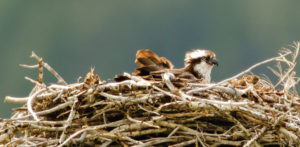
Restani bands about 70 birds per year.
In 2012, Restani joined the Osprey Project as a volunteer research director. He is licensed to band osprey nestlings, and garners the help of utility companies in order to access their nests for this purpose. Today, the Osprey Project relies on Beartooth Electric Cooperative, Montana-Dakota Utilities, NorthWestern Energy, Park Electric Cooperative, Yellowstone Valley Electric Cooperative, and Yellowstone Valley Tree Surgeons to reach the nests. And the power companies rely on the nest monitors to alert them of nests on power poles.
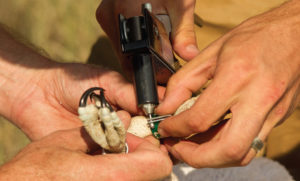
EVERY SPRING, OSPREYS MIGRATE from the Gulf Coast, Central America, and South America to build their nests along the Yellowstone River. They pile and weave sticks into nests 3- to 6-feet in diameter on platforms, tree limbs, and power poles — anywhere they can find a suitable location to perch, to fledge their chicks, and to hunt from.
They especially like power poles, which mimic dead trees, but nesting on an active power pole can lead to electrocution, and can also cause power outages and fires. When nest monitors report problem sites, the sticks are moved and a platform is set up nearby for safer nesting.
The birds are also faced with entanglement in baling twine. Often found along rural roads and ranch edges when it accidentally blows out of flatbed trucks, the twine attracts ospreys with its bright colors, and then the birds use it to build nests. During his library presentation, Restani shows photo after photo of birds caught in twine. Some he has been able to cut free, but many die. In response, Deb Regele, the nest monitor coordinator for the Osprey Project, is working on opening a baling twine recycling center.
Despite electrocutions and twine entanglements, ospreys are faring well. One of the reasons for their success is that they are adaptable, tolerant of humans, and will nest in quasi-urban areas, such the Western Sugar Cooperative factory in Billings, and the Livingston baseball fields. “They don’t care about noise or predictable disturbances,” Restani notes. “They put up with machines at the sugar plant and three days of fireworks in Livingston right near their nest.”
Starting in April, volunteers start checking their adopted nests and report back to Restani. He then enters the data in a national database, and based on reports of where banded birds have been sighted, he can learn more about where birds go once they leave the nest and how many survive.
There is a short banding window for a chick, as they have to be big enough to wear the bands but young enough to not get scared off during the process. When nest monitors report that eggs have hatched in a nest, Restani waits four to five weeks; then the local power company lifts him to the nest in a bucket truck. “The 40 volunteers doing this are a huge resource for me, and the power companies are so important for collaborating,” Restani says. “My being able to do this project is totally dependent on volunteers.”
Although he’s only been with the Osprey Project since 2012, Restani says, “I’ve been a raptor person my whole career.” He earned a bachelor’s degree from the University of Montana and a master’s degree from Montana State University, where a project on hawks inspired a deep connection with Montana raptors. For his doctorate from Utah State, he studied bald eagles on the Missouri River near Helena. After a post-doctoral research stint at the University of Washington, Restani spent the next 15 years as a professor at Rocky Mountain College in Billings and St. Cloud State University in Minnesota, where he is now a professor emeritus.
Although Montana is his permanent home, Restani spent seven summers in Greenland studying peregrine falcons and ravens. He passed two summers in Australia studying Tasmanian Devils, and four winters guiding in the Falkland Islands, South Georgia, and Antarctica. Through all these experiences and landscapes, Restani has worked with a diverse set of stakeholders and formed a practical conservation philosophy that serves him well working with Montana’s ospreys.
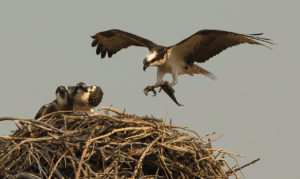
When Osprey Project volunteers see nests seit up on power poles, they alert Restani so that they can be moved to a nearby nesting platform, which is safer.
The Osprey Project is the beginning of a study that Restani hopes will continue for a long time. Of the approximately 70 birds that are banded each year, about 10 percent come back as breeders. That means a lot of birds need to be banded year after year to collect meaningful data. “With long-lived birds you have to have long-term data,” Restani says. “Long-term projects like this can only happen on a large spatial scale with a big group of volunteers.”
Restani and the nest monitors give a lot to the Osprey Project. They further our knowledge of these fascinating birds, while also saving avian lives. And thanks to the Osprey Project, utility companies can maintain power lines, and we all suffer fewer power outages.
But what Restani gets back, along with the osprey data, is a connection to the birds and people along the Yellowstone River. “The people I’ve met through this project have really enriched my life,” he adds.




No Comments